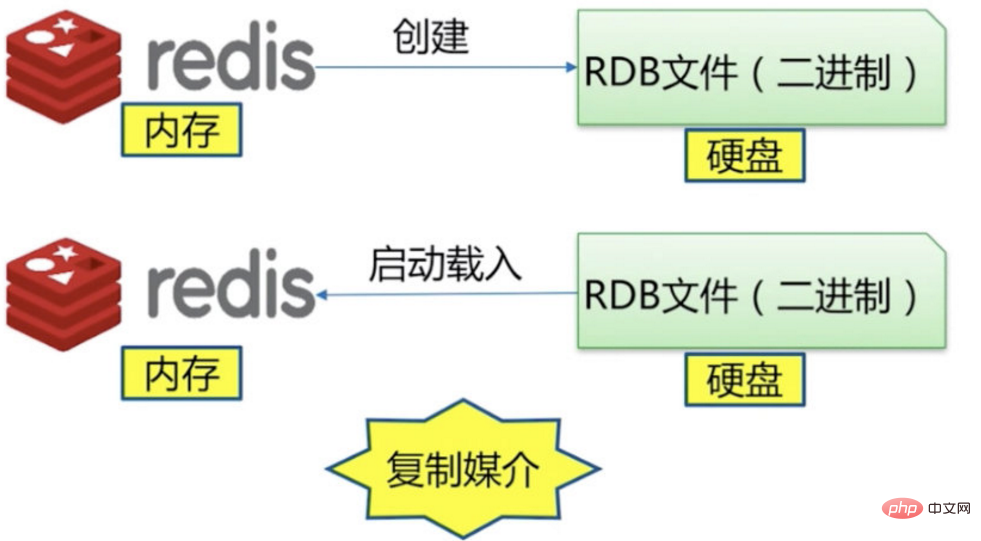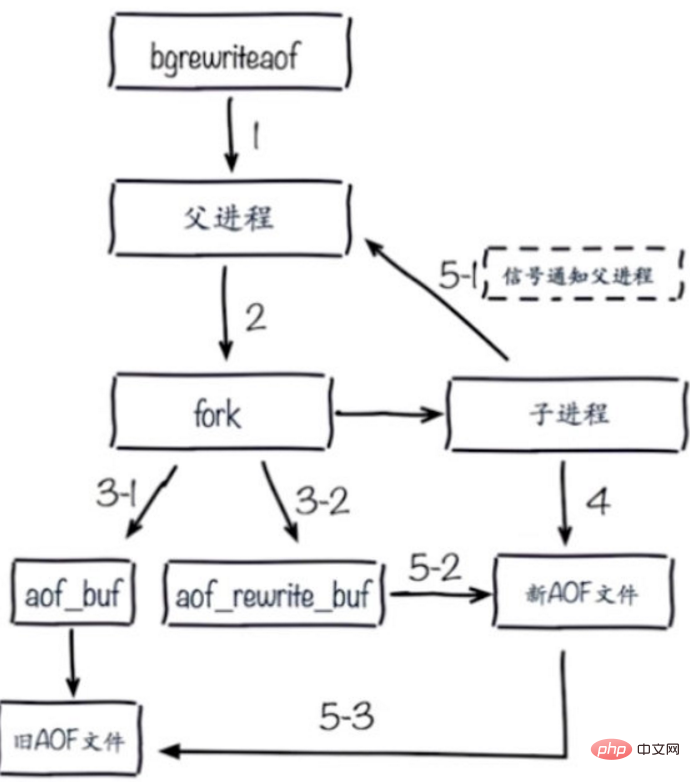How Redis implements persistence solution (used by RDB and AOF)
- WJforward
- 2020-05-30 11:51:542842browse
1. The role of persistence
1. What is persistence
All data saved by redis In memory, updates to data will be asynchronously saved to the hard disk
2. How to implement persistence
Snapshot: a completion of data at a certain time Backup - mysql's Dump - redis's RDB log writing: any operation is recorded in the log. To restore the data, just go through the log again - mysql's Binlog - Hhase's HLog - Redis's AOF
2. RDB
1. What is RDB

2. Trigger Mechanism-main three methods
The first one: save (synchronization)
1 The client enters the save command----》redis server----》Synchronized creation RDB binary file
2 will cause redis blocking (when the amount of data is very large)
3 File strategy: If the old RDB exists, it will replace the old one
4 Complexity o(n)
Second type: bgsave (asynchronous, Backgroud saving started)
1 The client enters the save command----"redis server----"asynchronous Create an RDB binary file (the fork function generates a child process (fork will block reids), execute createRDB, the execution is successful, and a reids message is returned)
2 When accessing redis at this time, the client will respond normally
3 File strategy: Same as save, if the old RDB exists, it will replace the old one
4 Complexity o(n)
The third method: (common method) (** ****) Automatically (through configuration file)
Configuration seconds changes
save 900 1save 300 10save 60 10000If 1w pieces of data are changed in 60s, automatically generate rdb
If 10 pieces of data are changed in 300s , automatically generate rdb
If 1 piece of data is changed in 900s, automatically generate rdb
If any of the above three conditions is met, the rdb will be automatically generated, and bgsave is used internally
#Configuration:
save 900 1 #Configure one
save 300 10 #Configure one
save 60 10000 #Configure one
dbfilename dump.rdb #The name of the rdb file, the default is dump.rdb
dir ./ #The rdb file exists in the current directory
stop-writes-on-bgsave-error yes #If an error occurs in bgsave, whether to stop Write, the default is yes
rdbcompression yes #Use compression format
rdbchecksum yes #Whether to checksum the rdb file
#Best configuration
save 900 1
save 300 10
save 60 10000 dbfilename dump-${port}.rdb
#With port As the file name, there may be many reids on one machine, so it will not be messy
dir /bigdiskpath #Put the save path to a large hard disk location directory
stop-writes-on-bgsave-error yes
#Error stop
rdbcompression yes #Compression
rdbchecksum yes #Verification
RDB trigger mechanism generally uses the first There are three ways, but this method also has shortcomings. If the number of modified items is not within the setting range, it will not be triggered, which will lead to a lot of data not being persisted. So we generally use the following method: AOF.
If you want to save unimportant data, you can use RDB (such as cache data). If you want to save very important data, you should use AOF, but both methods can also be used at the same time.
3. AOF
1. RDB problem
is time consuming and performance consuming. Uncontrollable, data may be lost.
2. AOF introduction
Every time the client writes a command, a log is recorded and placed in the log file. If there is a downtime, the data can be completely restored
3. Three strategies of AOF
The log is not written directly to the hard disk, but is first placed in the buffer. The buffer is written to the hard disk according to some strategies
#The first type: always: redis--》Write command refresh buffer---》Fsync each command to the hard disk---》AOF file
#The second type: everysec (default value ): redis——》Buffer refreshed by writing command---》fsync buffer to hard disk every second--》AOF file
#The third type: no:redis——》Buffer refreshed by writing command Buffer---》The operating system determines, the buffer fsyncs to the hard disk--》AOF file
| Command | always | everysec | no |
| Advantages | No data loss |
Once fsync per second, lose 1 second of data | Don’t worry |
| Disadvantages |
The IO overhead is large, and the average sata disk only has a few hundred TPS | lost 1 second data | Uncontrollable |
4.AOF rewriting
As the commands are gradually written, the amount of concurrency increases , the AOF file will become larger and larger, solve this problem through AOF rewriting
| Native AOF | ##AOF Rewrite |
|
set hello java set hello hehe incr counter ncr counter rpush mylist a rpush mylist b rpush mylist c Expired data ##set hello hehe |
set counter 2 rpush mylist a b c | ##The essence is to optimize expired, useless, repeated, and optimizable commands, which can reduce disk usage and accelerate recovery speed
AOF rewrite configuration:AOF configuration file (******)Rewrite process
 appendonly yes #Set this option to yes and open appendfilename "appendonly-${port}.aof " #The name of the file saved appendfsync everysec #Adopt the second strategy dir /bigdiskpath #The storage path no-appendfsync-on-rewrite yes #When rewriting aof, whether to do the append operation of aof, because aof rewriting consumes Performance, disk consumption, normal AOF writing to disk has certain conflicts, data during this period is allowed to be lost
appendonly yes #Set this option to yes and open appendfilename "appendonly-${port}.aof " #The name of the file saved appendfsync everysec #Adopt the second strategy dir /bigdiskpath #The storage path no-appendfsync-on-rewrite yes #When rewriting aof, whether to do the append operation of aof, because aof rewriting consumes Performance, disk consumption, normal AOF writing to disk has certain conflicts, data during this period is allowed to be lost
4. Selection of RDB and AOF
1. Comparison of rdb and aof
| rdb | aof | Startup priority |
| High (hang and restart, aof data will be loaded) |
Size |
|
| Large |
Recovery speed |
|
|
Slow |
Data security |
|
|
| Decided according to strategy
Light and heavy |
|
|
2.rdb best strategy Rdb is turned off, master-slave operation 3.aof best strategy Open: cache and storage, open in most cases, 4. Best strategy Small sharding: the maximum memory of each redis is 4g The above is the entire content of Redis (4)-persistence solution (used by RDB and AOF). Related references:PHP Chinese website |
The above is the detailed content of How Redis implements persistence solution (used by RDB and AOF). For more information, please follow other related articles on the PHP Chinese website!

